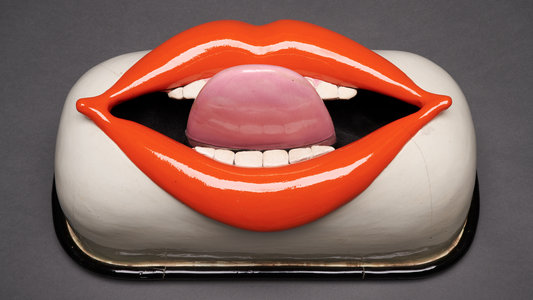When first starting an art collection it’s important to think about what is motivating you at your core. This will help determine specifically what and how you go about collecting. We often see people fall into one of five collector categories that are influenced most by their motivations for collecting in the first place. Keep in mind anyone can crossover or be a hybrid of multiple collector profiles.
Below are the ones we see the most often:
1. The Academic
This is your research-oriented, connoisseur type of collector who gets into the nitty-gritty niche of a particular artist’s oeuvre or movement or genre. One example of this would be someone who collects only 1960s minimalism or color field paintings from 1952-1954. This type of collector may have museum curator level knowledge and likes to speak with historians and artists directly in order to weigh in on their purchase decisions. An excellent example of this type of collector was architecture and interior design critic, Judith Neisser. Neisser’s art collection included remarkable examples of minimalism from the 1960s, with a special emphasis on minimalist and conceptual art. Neisser’s collection was sold at Sotheby's in 2018.
Source: https://www.sothebys.com/en/series/seeing-clearly-the-collection-of-judith-e-neisser
2. The Passionate Advocate
This is a collector who is driven by a passion for arts patronage, civic engagement, or a particular cause or group. For this type of collector, there is often a subject of personal importance that drives who they're interested in and what work they purchase. One of my favorite examples of the Passionate Advocate is radiologist and collector, V. Joy Simmons. Simmons is both a passionate advocate of arts patronage and civic engagement. Sarah and I visited Joy’s home back in 2020 and were blown away by her collection. Her passion and warmth emanated from every room in her house, and every interaction we had with her.
“Growing up we had lots of white walls. But as a teenager music was my real passion — Jimi Hendrix! So when I went to Stanford, I always had music posters over my room. As a freshman, I went to New York City for the first time. My uncle is a jazz musician and his wife, Janet, was a significant patron of the arts — she was on the founding board of the Studio Museum in Harlem. My girlfriends and I would go and stay with aunt Janet every year for Spring Break. On one trip, there was a Romare Bearden show at MoMA and I bought a poster. I took that poster back to Stanford put it up in my room next to Hendrix — that was the start. I still tell people today — you can start with a poster. That’s how you can develop your eye and taste inexpensively.”

John Edmonds, Untitled (Hood 2), 2016 (left), Deborah Roberts, Act of Power, 2018 (right). Courtesy: V. Joy Simmons

Basil Kincaid, Reclining, 2018 (wall), Sanford Biggers, Cloud, 2001, (ceiling), Oscar Murillo, Untitled, 2013, (table, left), Kerry James Marshall plate, (table, right)
“Taking the step from collecting to this kind of patronage means you’re not just projecting your thoughts or telling your stories: you’re making sure everyone has a chance to tell theirs too. Some patrons I know make sure their donations to institutions go towards education. As a result, you see kids come to LACMA who don’t know where Wilshire Blvd is — their experience is widened before they even see any art, just by being in another part of town. And for them to see the Kerry James Marshall exhibition at MOCA? To see their reactions to that? It’s mind-blowing. It’s priceless. That is what it’s all about.”
Source: https://www.frieze.com/article/vjoy-simmons-shares-her-secrets-collecting-art
3. The Trophy Hunter
This is someone who collects recognized world-class, blue-chip artists, prioritizing museum quality, iconic works. For these types of collectors, often money is no object as long as they acquire the best of the best. When you read the headlines in the newspaper when a Jean Michel Basquiat sells for $100+M, this is the result of two trophy hunter type collectors duking it out at auction for that A+ quality work where nothing else will substitute. An excellent example of a trophy hunter collection that you can see publicly is the Broad Museum. Paul Allen was another example of a trophy collector. Allen’s collection, which recently sold via Christie’s auction, can be viewed here. Allen, who started Microsoft with Bill Gates in 1975, frequently loaned his pieces to museums and galleries. In 2015, he created the Seattle Art Fair as part of his passion for showcasing art. “To live with these pieces of art is truly amazing,” Allen told Bloomberg at the time. “I feel that you should share some of the works to give the public a chance to see them.”

4. The Decorator
The decorator type of collector is simply someone who recognizes fine art and design are an essential part of bringing a beautiful space to life. This could be someone just starting out or someone who has been in the game for 10+ years and appreciates looking at art, learning about the process and concepts, and enjoys putting together works in primarily an aesthetically-driven way. Some great examples of collections like this can be found here.

Source: https://www.architecturaldigest.com/gallery/home-art-display
5. The Investor
This is a collector who buys and sells works of art for a profit. This kind of collector is sometimes nicknamed the “art trader” or “art flipper," depending on their investment horizon. This collector also typically has a keen eye and deep pockets to play the game and invest in works (often by emerging artists) with the hope that they will appreciate in value and then sell for a profit. This can also be someone who collects solid blue-chip artists with a longer-term hold strategy and enjoys living with the pieces while they appreciate prior to selling. In some cases, this collector won’t even see the artwork at all; they will simply buy, store, and sell when the time is right.
Again, this is just an outline of different types of collectors and their motivations for collecting. There is no rigid definition or categorization of what this looks like, but rather a way to think about your approach to collecting based on your motivations. No matter how you’re motivated, we always recommend buying what you love and living with it for a minimum of 3-5 years.



